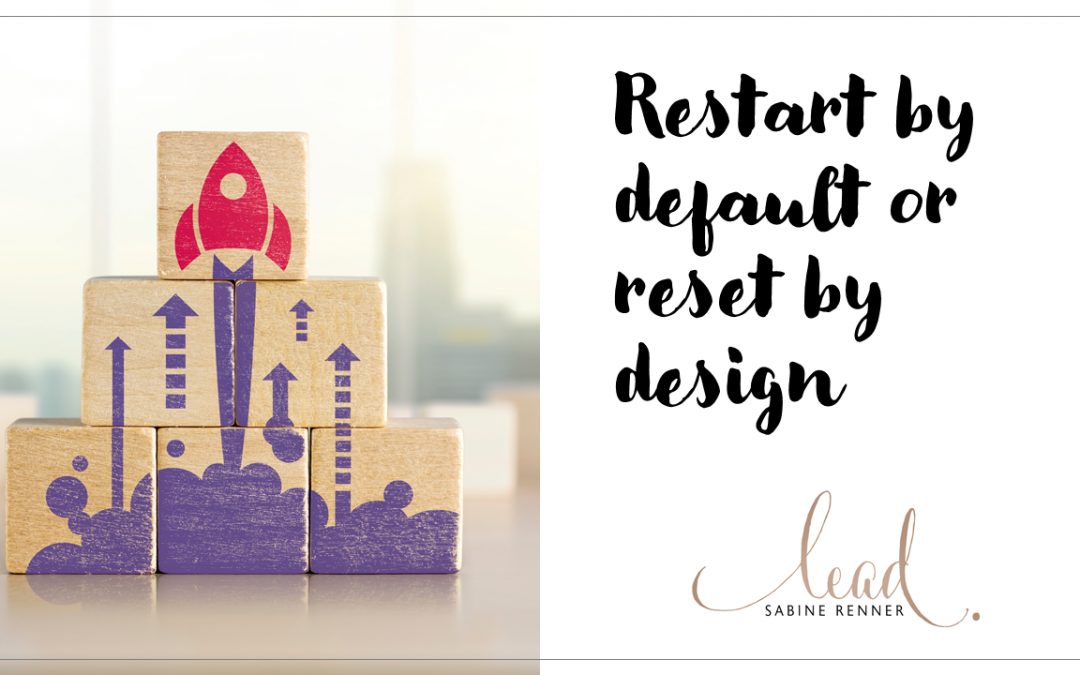Living in today´s world, creating a career you thrive in, leaving a positive mark as a leader while also nurturing your personal life can be demanding. My clients often come to coaching because they want to create MORE in their lives and careers. More success, impact, effectiveness and efficiency, clarity, focus, and alignment. Or they aim to have LESS – less stress, confusion, or disconnect from others.
While the goal is often apparent, the way to get there is not. Why? Because whatever the goal is, it more often than not requires a change to happen. Changing the way we do things or the way we look at life and others.
It might be very tempting to hope that one day when the environment or the people around us change, it’ll all be fine. But the truth is, things and people might change … or not. So, instead of hoping for better circumstances, taking action ourselves and changing what needs to be changed is often much more promising. Instead of trying hard to change the possibly unchangeable, we focus on the one thing that we can control and change – ourselves, our thoughts, and our actions.
That change could point into many different directions. It could require us to do more of something or to create something new. It could also mean doing less or completely abandon a particular behavior. We might have to change the way we think, the way we behave and take action or the way we interact with others.
While it sounds to intuitive and logical, lasting behavioral change can be one of the most challenging tasks. Why is that? Dr. Marshall Goldsmith, Executive Coach, bestselling author, and well-known leadership expert, offers an answer to that. According to Marshall, the reason is that we have to manage change in an imperfect world, full of triggers that might pull and push us off course.
I had the opportunity to meet Marshall in 2019 for a one-day workshop with fellow coaches selected for Marshall´s 100 Coaches initiative. During this workshop, Marshall shared very insightful ideas on how to successfully manage behavioral change.
Here are the key findings from the workshop, complemented with takeaways from his bestseller ‘Triggers: Creating Behavior that Lasts – Becoming the Person You Want to Be.’
Let´s start by looking at the question ‘What’s a trigger?’.
According to Marshall, a trigger is a stimulus that has the power to reshape our thoughts and actions. In every waking hour, we’re facing people, events, circumstances, all of which have the potential to trigger and change us – to the better or worse.
As we go through life, we make plans, we set goals and often link our happiness and satisfaction to the achievement of these. However, as we pursue these goals, our environment keeps on intervening and puts us to the test.
It´s the chocolate cake offered when we’re trying to lose some extra pounds. Or the pressing deadline at work that causes us to skip the evening fitness class that we intended to join. The thoughtless comment made by a colleague during the team meeting that caused us to snap back and lose face in front of our boss…and the list goes on. We have all been there.
Our environment is indeed the most potent triggering mechanism. Sometimes, these triggers have a massive impact without us even noticing that they are at work. And once we realize, it is so tempting to feel like a victim to circumstances, ignoring that we do have a choice. As Marshall puts it: ‘Fate is the hand of cards we’ve been dealt. Choice is how we play the hand’.
So how can we proactively choose for the better? It requires three steps:
STEP 1 – KNOW YOUR TRIGGERS
A trigger is any stimulus that can impact our behavior. Now, the challenge with triggers is that they can tempt us to enjoy short-term benefits, instead of sticking to what is needed to achieve the long-term positive results we’re aiming for.
We have to continuously choose how to respond to our triggers. And with short-term pleasures being so appealing, we’re put to the test. There’s this permanent inherent conflict: Should we give in and follow short-term temptations or be in there for the long-term, even if it requires much discipline and sticking to rules and routines?
Marshall suggests an easy to follow-through yet very insightful exercise to make us smarter about our triggers. It also helps us to connect these triggers directly to our own behavioral successes and failures. It goes as follows:
- Pick a behavioral goal you are pursuing.
- List the key people and situations that influence the quality of your performance in the respective area. This means the kind of triggers that could cause you to either follow through or deviate from the plan and desired behavior.
- Check your triggers and the response they cause in you.
Be aware of the fact that some triggers might be enjoyable, yet cause us to detour. That´s when praise, recognition, or admiration trigger a specific behavior in us, which, however, might be counterproductive considering our goal. When the charming feedback we receive causes us to take on more workload than we should because ‘saying no’ just seems inappropriate. Or when a trigger allows us to get pleasantly distracted or to be tempted into something which we enjoy instead of doing what needs to be done. Or when we can stay in our beloved comfort zone.
In these moments, we’re simply getting too much of what we want (pleasure, comfort, acknowledgment, …) but not enough of what we need to follow through. Meaning those triggers such as rules, routines, anticipated pain, or consequences that cause us to stay committed and take action towards our goals.
So, observe yourself and your response patterns – focusing on both the bigger and smaller actions, keeping in mind that they all accumulate. Success is not the result of winning in one big moment but typically built on many consistent day-to-day actions and the aligned choices leading to these.
Often, we excel in high-pressure moments when the stakes are high, just to find ourselves stumbling through little, day-to-day moments when we´re on autopilot. When life is taking a detour and triggers us to respond in a not so productive way.
STEP 2 – CHOSE CONSCIOUSLY HOW TO REPOND BETTER
Once we become aware of the trigger and understand which impulse it causes, we can think about better strategies to respond.
One option could be to avoid or bypass the trigger. If that´s not possible, we could choose other behavioral strategies.
That means that we, rather than being on autopilot, take the time to think it over and make more conscious choices. We create strategies, structures, and new routines that help us stay in alignment with the behavior we want to show to reach the objectives that we aim for.
So, ask yourself:
- What triggers could come in the way between you and your goals, and how could you choose better response alternatives that are in alignment with who you are and where we want to go.
- Considering the objective that you want to achieve – what behavior would help you to get there more effectively?
STEP 3 – MAKE STRUCTURE AND ROUTINES YOUR ALLIES
An easy to establish, yet very impactful structure we can use to keep ourselves on track is the routine of Daily Engaging Questions.
How does it work? Let´s look at an example.
Imagine your objective is to communicate more effectively with your colleagues at work. To achieve this, you want to focus on:
- listening more actively,
- changing perspective to understand the other side better,
- and using an engaging language to convey your ideas.
Your goal is clear, and so is the way to get there, meaning the behaviors which you want to show.
At the end of each day, you could now use Daily Engaging Questions to reflect on how well you did concerning these behaviors.
Asking yourself an engaging question means that you ask yourself:
‘Did I do my best to … listen actively, change perspective, use engaging language’
instead of just asking
‘Did I do…’.
Asking ourselves whether ‘we have done our best’ causes us to challenge ourselves and to no longer be satisfied with ‘good enough.’ It triggers us to strive for continuous improvement. As a consequence, we achieve our goals even faster as we get better and refine our strategies over time.
At the same time, ‘Doing our best’ questions trigger us to focus on the effort – not the result. We acknowledge that any change in behavior takes time and that any setbacks or challenges along the way should not stop us from pursuing our dreams and goals. If we make an effort, we will get better. If we don´t, we won´t. It’s as simple as that, and Daily Engaging Questions are a powerful reminder for us to stay on track.
So, once you have defined your list of questions, score them on a scale from 1 – 10, with ten implying that you have done your absolute best. Then ask yourself what the scores are telling you as you review them.
A consistently low score gives you precious feedback. Maybe there are still triggers to be overcome, or other strategies could yield better results. Or perhaps it tells you that what you thought is important is simply not important enough for you. Remove and replace those questions which are no longer valid. Over time, your list will change, but it will always remain a potent tool to learn, progress, and achieve your goals.
How can you come up with your list? Here are some tips:
- Keep in mind that this list is yours. It should reflect your objectives, not those of others. So, don´t worry about being judged or the need to impress anybody else other than you.
- Ask yourself whether whatever you put as a question refers to something significant to you in your life right now.
- Check-in with yourself and ask whether success on these items will help you become the person you want to be and to achieve the goals you have set for yourself.
Whatever your goal is, keep in mind that change is possible but will most likely not happen overnight. Our successes are the sum of the small efforts repeated day in day out. So, know your triggers, consciously choose productive strategies to drive your behavior and actions towards success and alignment, and follow through wholeheartedly. Doing so will help you living and leading with intention and impact and creating a career and life you thrive in.






Recent Comments